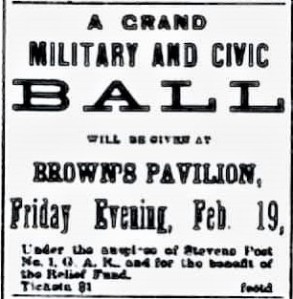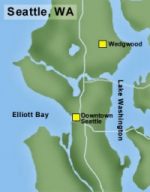
Wedgwood neighborhood in northeast Seattle. Map courtesy of HistoryLink.
In Seattle in the 1870s it was still possible to obtain land in a homestead claim. Some who came to Seattle were young adventure-seekers, but many who came seeking land were older men who were trying to make a fresh start; some were veterans of the Civil War.
Veterans of the Union Army who fought in the Civil War, 1861-1865, received credit for time served in the war so that they did not have to take a full five years to “prove up a claim” and be awarded ownership of land, according to the Homestead Act of 1862. They would deduct the number of years served in the war and then only had to live on the homestead claim until the remainder of the time, plus build a house.
Washington Territory did not send troops to the Civil War but after the war, veterans from all over the USA were attracted to the Pacific Northwest by the availability of land. In the 1870s the first white settlers in the Wedgwood area were Civil War veterans who had come from other states of the USA.
Civil War veterans make land claims in northeast Seattle
In 1873 two brothers, Robert & William Weedin of Missouri, came to Seattle with their families. Both men were Civil War veterans and, while looking around Seattle and deciding what to do, they worked as policemen. (Descendants of Robert Weedin continued to serve in law enforcement into the twentieth century. See Seattle Times article of February 6, 2010, and HistoryLink Essay #3811.)
Robert Weedin took a homestead claim in the Green Lake area, and today the street named Weedin Place marks part of his land. His brother William Weedin’s land claim included Wedgwood Rock south of NE 75th Street and east of 25th Ave NE.
Although the Weedins listed themselves on the census as farmers, it meant primarily that they were landowners. The Weedin men worked at logging off the trees on their land and they also supported themselves doing carpentry work.
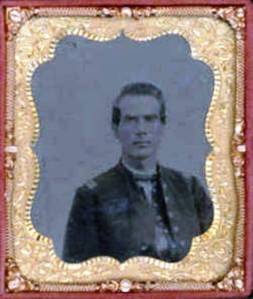
Capt. DeWitt C. Kenyon in Civil War uniform. Courtesy of http://www.findagrave.com/
Around the same time, the Kenyon & Dunham families of Michigan also ventured out to Seattle. At the conclusion of the Civil War in 1865, Captain DeWitt C. Kenyon of Company B, 13th Michigan Infantry, mustered out and returned home to the village of Plainwell where his sweetheart, Viola, awaited him. Viola Dunham had spent the war years teaching school while living with her parents, Calvin & Mary Dunham.
After the Civil War everyone hoped for peace and a return to “normal,” but it was not to be. The civil strife had literally torn the nation apart and there continued to be social and political turmoil, plus the economic recession which often is the aftermath of war. It was very common for Civil War veterans to return home, and then, finding that home was not the same, veterans decided to leave and start a new life elsewhere. Many, like the Kenyons, became part of the Westward movement as they sought to start over with a fresh slate.
By the early 1870s in Michigan DeWitt & Viola Kenyon had experienced the loss of three children, two as infants and the death of their three-year-old son, Walter. At the other end of the life spectrum, Viola’s parents, Calvin & Mary Dunham, were aging and could no longer work their farm. The Dunhams & Kenyons resolved to leave all they had known in Michigan and make a new start out in the wilds of Washington Territory, which had not yet entered the Union as a state.
Viola’s brother Clifford Dunham came, too, and with his family settled in northeast Seattle at around NE 65th Street & 15th Ave NE, between the claims of the Weedin brothers. Viola’s sister Addie (younger by eleven years) and Addie’s husband Charles F. Deibert took a claim south of Clifford’s in what is now Ravenna at about NE 65th Street. Corporal Deibert had served in the Civil War with Company A, 20th Indiana.
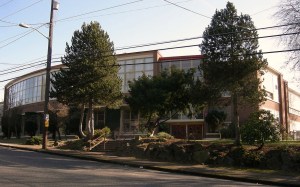
The site of Nathan Eckstein School at 3003 NE 75th Street is part of the original homestead claim of Capt. DeWitt C. Kenyon.
In 1874 Capt. DeWitt C. Kenyon took a homestead claim between what is now NE 75th to 80th Streets, 30th to 45th Avenues NE. Years later, after the land had passed to other owners, the land was platted as the State Park Addition from 30th to 35th, and Oneida Gardens from 35th to 45th Avenues NE.
Capt. Kenyon’s homestead claim was L-shaped and part of it was south of NE 75th Street, from 30th to 35th Avenues NE between NE 70th to 75th Streets. Eckstein Middle School is on part of that site.
No records remain of where the Kenyon’s log cabin was located, but it is my belief that the Kenyons may have lived on the present site of Eckstein Middle School because it was a cleared area from very early years. The Eckstein site was used as a pasture in the early 1900s, so the fact that it had been cleared of large trees may indicate that the Kenyons’ cabin had once been there.
The Kenyons get involved in activities in Seattle
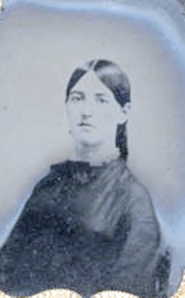
Viola Kenyon was active in Seattle in the 1870s and 1880s as a schoolteacher and member of the Grand Army of the Republic organization. Photo courtesy of http://www.findagrave.com/
On the census of 1880 in Seattle Viola Kenyon listed herself as a schoolteacher, which was remarkable for a married woman; in those days homemaking took so much time that a job outside the home was impossible. The key to Viola’s success was her parents, Calvin & Mary Dunham, who lived with the Kenyons.
In those log-cabin days, household work included the time-consuming process of gathering ingredients and cooking, all the while making sure that the fire in the fireplace did not go out. The Dunhams were able to do the home work of caring for the vegetable garden, splitting firewood, tending the hearth, and watching the food so that it didn’t burn, freeing Viola to teach school in a cabin built for the purpose on the claim property of William Weedin.
The childless Viola Kenyon taught the children of homesteaders such as the Weedins, as well as her three nieces, the daughters of Clifford Dunham. Weedin School, as it was called, is considered the “ancestor” of Bryant Elementary School. Weedin School served children in the four-mile area north of Lake Union between Lake Washington and the crest of Phinney Ridge.
It seems that children came from as far as the Fremont area to get the benefit of Viola’s classroom instruction and personal attention. We know this because such a child was recorded on the census of 1880 as staying with Viola’s sister, Addie, and her husband Charles Deibert. Little Mary Schurmandt, age 7, had a German immigrant father and a native American mother. The Schurmant (Scheuerman) homesite was on what is now N. 45th Street between Fremont & Aurora Avenues. From notations on land deeds we know that the mother, Peggy, was illiterate. Perhaps Viola Kenyon felt a special concern for little Mary because her mother would not be able to teach her to read, and so the Kenyons, Deiberts & Dunhams all helped with the Weedin School and they kept this child at their home for a tutoring session.
In 1881 one of the extended Dunham-Kenyon family members may have been the writer of a letter to the editor of the Post-Intelligencer newspaper, telling of a Fourth of July picnic at what was then called Lone Rock (Wedgwood Rock) on the homestead claim site of William Weedin.
The letterwriter’s initials were C.F.D., so it could have been Charles F. Deibert whose wife Addie, was Viola Kenyon’s younger sister. (Addie died in October 1880 here in Seattle.)
The writer of the 1881 letter to the newspaper showed pride in the students of Weedin School and told of the patriotic celebration at Lone Rock. For this reason it may have been Viola Kenyon, the teacher, who wrote the letter but it was carried to the newspaper office by her brother-in-law Charles F. Deibert, whose initials were then placed on the letter.
In about 1883 the Kenyons moved into town, where Capt. Kenyon worked at the Oregon Improvement Company sawmill at Second & King Streets. His occupation was “joiner,” similar to carpenter but unlike a carpenter who works on-site and frames houses, a joiner works in a workshop and makes wood components. DeWitt Kenyon’s occupation was listed as a sash and door maker.
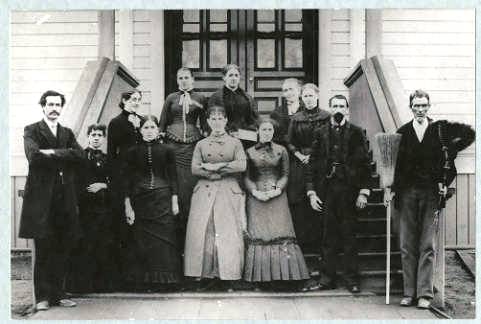
Central School of Seattle: photo of the faculty taken on Opening Day, May 7, 1883. School Principal E.S. Ingraham stands at left. Mrs. Viola Kenyon is at center in the back row. Photo courtesy of Seattle Public Library Historical Photograph Collection.
While living in town Viola Kenyon taught at Seattle’s Central School; she is on Bagley’s History of Seattle list of teachers for the 1883-84 school year. Prof. E.S. Ingraham, first superintendent of Seattle Schools, would have known of Mrs. Kenyon’s work at Weedin School in the 1870s and early 1880s.
It was said that Prof. Ingraham knew every family in Seattle, and for that reason he had been put in charge of the federal census of 1880. It is probably due to his exacting oversight that native Americans and other minorities, such as the Chinese, were included on the census of 1880. Prof. Ingraham was later “pressured out of his job” as superintendent of schools because he opposed the expulsion of the Chinese from Seattle in 1886 (see source notes at the end of this article.)
The Grand Army of the Republic in Seattle
During their years of living in Seattle the Kenyons kept busy with the Washington Territory branch of the Grand Army of the Republic. The GAR was a nationwide veteran’s organization for Union soldiers, and from the 1860s to the 1890s it was a powerful political movement.
The GAR was responsible for establishing May 30th as Memorial Day, originally intended to commemorate the dead of the Civil War. The GAR set the historical precedent for establishing the normal retirement age at 65, a decision made by the Civil War pension board in 1890.
The Kenyons helped establish the GAR of Washington in 1878, which was named Stevens Post No. 1 in honor of the territorial governor of the 1850s, Isaac I. Stevens. Stevens was a career military man and after finishing his service in Washington Territory, in 1862 Stevens was killed while serving as a Union officer in the Civil War. In 1885 Viola Kenyon founded the Women’s Auxiliary Relief Corps of the GAR in Seattle, an organization which aided widows and orphans of Union soldiers. The Relief Fund was mentioned in newspaper event notices like the one here from February 1886, a fundraiser.
The Kenyons move to California
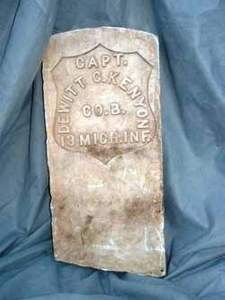
Gravemarker of Capt. DeWitt C. Kenyon, Company B, 13th Michigan Infantry. Courtesy of http://www.findagrave.com/
Viola Kenyon’s parents, Calvin & Mary Dunham, and her brother Clifford Dunham all returned to Michigan in the mid-1880s. Perhaps they were homesick or they had found the frontier life in Seattle harder than they expected.
In the 1880s several other members of the Dunham and Kenyon families migrated from Michigan to California. In 1888 DeWitt & Viola Kenyon moved to Ventura, CA., where DeWitt’s brother Gurdin also lived. Two of Viola’s brothers, Alos and Orville, were in Los Angeles, about seventy miles away.
Capt. DeWitt C. Kenyon died in 1903 at age 76 and was buried in Ventura, CA. There had been four Kenyon brothers and at least one brother-in-law who had all served in the Civil War in various Michigan units. Of these five men, one was killed in the war and one died later of injuries.
The war was the defining event of the Kenyons’ lives and reflected the high idealism of their desire to save the Union. The state of Michigan was renowned for its rapid response to the call for units to fight in the Civil War, and veterans like DeWitt Kenyon and his surviving brothers were proud and patriotic.
Viola Kenyon’s later years in Washington State
After her husband’s death in 1903, Viola, age 63, went to live with her brother Orville Dunham and his family in Los Angeles. It is not known why Orville Dunham moved again, but by 1910 he was in Olympia, Washington, and was proprietor of a store. Viola Kenyon lived with the Dunhams and spent the rest of her life in Olympia, where she resumed her activities with the Women’s Auxiliary of the Grand Army of the Republic in Washington State. She lived to be 91, dying in 1931. She is buried in a section for the Women’s Auxiliary of the GAR, in the Lake View Cemetery on Capitol Hill in Seattle.
In 1909 at age 69 Viola Kenyon travelled back to Michigan for the 44th reunion of her husband’s military unit. The following is the first stanza of a narrative poem she composed and read at the reunion. The complete text can be found at www.findagrave.com (Dewitt C. Kenyon.)
“To the Thirteenth Infantry” by Viola Kenyon
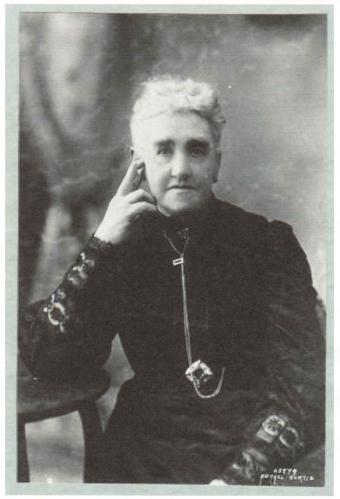
Viola Kenyon in 1910 at age 70. Photo by Asahel Curtis, courtesy of the Seattle Public Library Historical Photograph Collection.
When Sumter fell by traitor hands, and war-clouds dark hung low,
When anxious hearts prayed for one gleam of light to cheer their woe –
When men with patriotic zeal sprang to their country’s aid;
And mothers, wives and sweethearts, too, upon the altar laid
Their bleeding hearts; (Oh gift most rare) and bade their loved ones go
Perchance to die, that the dear old flag might never be laid low,
Then came the “Boys” of Michigan, the boys we loved so well;
They bade good-bye to wife and home, none braver fought or fell.
Their deeds are told on many a page; their fame will never die;
For Michigan did well her part and kept her standard high.
Sources:
Bagley, Clarence B., History of Seattle. 1916. Volume 1, Chapter VIII, “Educational Activities,” p. 161-177. Page 169: Mrs. Kenyon listed as one of the city school teachers in 1883-84. Page 170: Prof. Ingraham “had been active in his support of law and order at the time of the Chinese riots here in 1886 and thereby had incurred the enmity of a certain class in the city, of large voting strength.” Volume 2, chapter on fraternal organizations – Page 583: the Women’s Relief Corps of Stevens Corps No. 1, Grand Army of the Republic, was organized 1885.
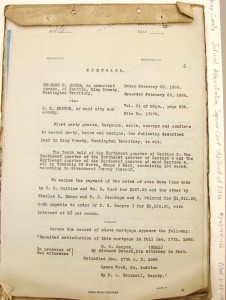
Title abstract showing the purchase of property owned by Capt. DeWitt C. Kenyon, a purchase of 1888 by Charles H. Baker and some co-investors. Document on file at the Puget Sound Regional Archives, Bellevue, WA.
“Bryant School,” Building for Learning – Seattle Public School Histories, 1862-2000, by Nile Thompson & Carolyn Marr. www.seattleschools.org/
Bureau of Land Management (BLM) General Land Office (GLO) Records, land patents for Robert Weedin, William Weedin, DeWitt Kenyon, Clifford Dunham. www.glorecords.blm.gov/ Special thanks to John LaMont, Seattle Public Library genealogist, for help on how to read land patent records.
Civil War Pension cards, http://www.fold3.com/ (DeWitt C. Kenyon)
Consultation, Greg Lange/research assistant, Puget Sound Regional Archives, Bellevue, WA.
Consultation, Nancy Robison, Kenyon family researcher, via e-mail 7/2/2012.
Federal census: 1850, 1860, 1870 Michigan; 1880 Washington Territory; 1900 California; 1910, 1920, 1930 Washington State.
Grand Army of the Republic Cemetery Park, Seattle. Friends of the GAR Cemetery Park, www.fgar.org
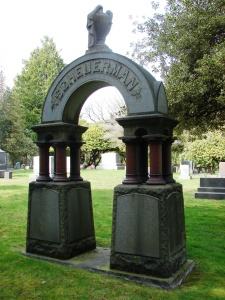
The Scheuerman family monument at Mt. Pleasant Cemetery on Queen Anne Hill in Seattle. The family burials are clustered around the marker. Photo by Valarie.
Gravesite list, www.findagrave.com Dewitt C. Kenyon, Viola A. Kenyon (photos of the Kenyons and their gravestones.)
Gravesite list, www.lakeviewcemeteryassociationcom/ Burial index, Viola A. Kenyon.
“Luther Weedin,” History of King County by Clarence Bagley, 1929. Volume 4, pages 214-220. Seattle Public Library, Seattle Room R979.72 B146. (Son of William Weedin, contains info about the family’s arrival in Seattle and what they did here.)
Michigan Infantry, www.civilwararchive.com/ 13th Regiment Infantry.
Michigan Family History Network, www.mifamilyhistory.org/ Census of the State of Michigan, Soldiers, Sailors and Marines.
Newspaper articles:
Hanbey, Russ, “1916 Seattle was a hotbed of sin when two officers were killed.” The Seattle Times, February 6, 2010.
“Capt. D.C. Kenyon Dead,” Seattle Post-Intelligencer, November 14, 1903, page 8.
“Viola A. Kenyon, W.R.C. Founder, Dies in Olympia,” Seattle Daily Times, August 6, 1931, page 18.
Other sources:
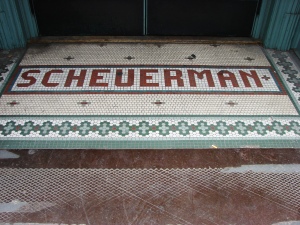
The spelling of the name of German immigrant Christian Scheuermandt was modified over time. This is the final spelling he preferred, which he had put in tiles of his building at the northeast corner of 1st and Cherry Streets, one of the first buildings put up after Seattle’s Great Fire of 1889. The tiles are in a doorway on the Cherry Street side of the building. Photo by Valarie.
Polk’s Puget Sound Directory 1887, listing for DeWitt C. Kenyon: sash & door maker at Oregon Improvement Company Sawmill at 2nd & King. Residence: northwest corner S. 9th & King.
Title Abstract of 1888, sale of land owned by Capt. DeWitt C. Kenyon to Charles H. Baker and a group of investors. Baker platted this land as the State Park Plat. Document on file at the Puget Sound Regional Archives.
Volume of Deeds, King County Recorder’s Office, Vol. 18 p. 51, 5 October 1880. Sale of land from Christian & Peggy Schuerman to O.S. Wright, the N ½ of the E ½ of the NE ¼ of Section 18, Township 25, Range 4. Notation “her mark” for Peggy signifies that she was illiterate.
Washington Territorial Census, 1883, 1885, 1887, listings for D.C. Kenyon.
University of Washington Digital Library portraits of Civil War veterans: Corporal Charles F. Deibert (1837-1901) served with Company A, 20th Indiana Regiment. This portrait was taken at a Grand Army of the Republic event by Seattle photographer F. LaRoche.
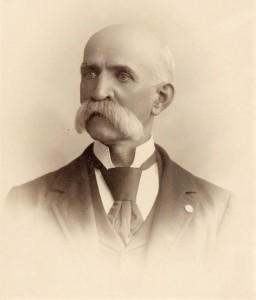
Corporal Charles F. Deibert of Indiana, lived in Seattle for about twenty years. He died at an Old Soldiers Home in California in 1901.


